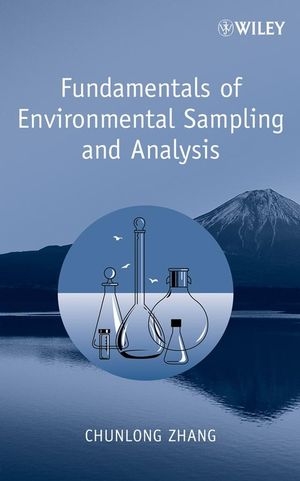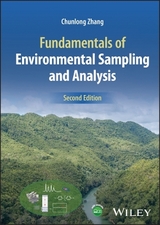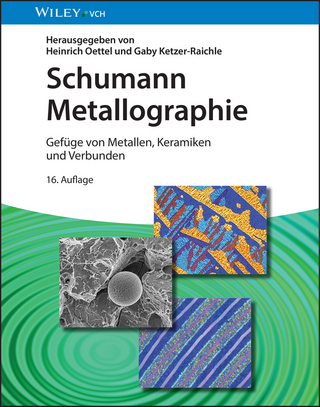
Fundamentals of Environmental Sampling and Analysis
John Wiley & Sons Inc (Verlag)
978-0-471-71097-4 (ISBN)
- Titel erscheint in neuer Auflage
- Artikel merken
An integrated approach to understanding the principles of sampling, chemical analysis, and instrumentation This unique reference focuses on the overall framework and why various methodologies are used in environmental sampling and analysis. An understanding of the underlying theories and principles empowers environmental professionals to select and adapt the proper sampling and analytical protocols for specific contaminants as well as for specific project applications. Covering both field sampling and laboratory analysis, Fundamentals of Environmental Sampling and Analysis includes:
A review of the basic analytical and organic chemistry, statistics, hydrogeology, and environmental regulations relevant to sampling and analysis
An overview of the fundamentals of environmental sampling design, sampling techniques, and quality assurance/quality control (QA/QC) essential to acquire quality environmental data
A detailed discussion of: the theories of absorption spectroscopy for qualitative and quantitative environmental analysis; metal analysis using various atomic absorption and emission spectrometric methods; and the instrumental principles of common chromatographic and electrochemical methods
An introduction to advanced analytical techniques, including various hyphenated mass spectrometries and nuclear magnetic resonance spectroscopy
With real-life case studies that illustrate the principles plus problems and questions at the end of each chapter to solidify understanding, this is a practical, hands-on reference for practitioners and a great textbook for upper-level undergraduates and graduate students in environmental science and engineering.
Chunlong (Carl) Zhang, PhD, is an Associate Professor of Environmental Science and Environmental Chemistry at the University of Houston-Clear Lake. He has over two decades of experience in academia, industry, and consulting. Dr. Zhang has firsthand, practical knowledge of environmental sampling and analysis from work in the field and in the lab. He is the author or coauthor of numerous articles and reports on contaminant fate/transport, environmental remediation, and environmental assessment.
Preface xvii
1. Introduction to Environmental Data Acquisition 1
1.1 Introduction 1
1.1.1 Importance of Scientifically Reliable and Legally Defensible Data 2
1.1.2 Sampling Error vs. Analytical Error During Data Acquisition 4
1.2 Environmental Sampling 5
1.2.1 Scope of Environmental Sampling 5
1.2.2 Where, When, What, How, and How Many 6
1.3 Environmental Analysis 6
1.3.1 Uniqueness of Modern Environmental Analysis 7
1.3.2 Classical and Modern Analytical and Monitoring Techniques 7
References 9
Questions and Problems 10
2. Basics of Environmental Sampling and Analysis 11
2.1 Essential Analytical and Organic Chemistry 11
2.1.1 Concentration Units 11
2.1.2 Common Organic Pollutants and Their Properties 14
2.1.3 Analytical Precision, Accuracy, and Recovery 16
2.1.4 Detection Limit and Quantitation Limit 17
2.1.5 Standard Calibration Curve 18
2.2 Essential Environmental Statistics 20
2.2.1 Measurements of Central Tendency and Dispersion 20
2.2.2 Understanding Probability Distributions 21
2.2.3 Type I and II Errors: False Positive and False Negative 25
2.2.4 Detection of Outliers 26
2.2.5 Analysis of Censored Data 28
2.2.6 Analysis of Spatial and Time Series Data 29
2.3 Essential Hydrology and Geology 30
2.3.1 Stream Water Flow and Measurement 30
2.3.2 Groundwater Flow in Aquifers 31
2.3.3 Groundwater Wells 32
2.4 Essential Knowledge of Environmental Regulations 35
2.4.1 Major Regulations Administrated by the U.S. EPA 35
2.4.2 Other Important Environmental Regulations 35
References 37
Questions and Problems 39
3. Environmental Sampling Design 45
3.1 Planning and Sampling Protocols 45
3.1.1 Data Quality Objectives 46
3.1.2 Basic Considerations of Sampling Plan 48
3.2 Sampling Environmental Population 49
3.2.1 Where (Space) and When (Time) to Sample 49
3.2.2 Obtain Representative Samples from Various Matrices 49
3.3 Environmental Sampling Approaches: Where and When 52
3.3.1 Judgmental Sampling 52
3.3.2 Simple Random Sampling 53
3.3.3 Stratified Random Sampling 54
3.3.4 Systematic Sampling 56
3.3.5 Other Sampling Designs 57
3.4 Estimating Sample Numbers: How Many Samples are Required 61
References 63
Questions and Problems 63
4. Environmental Sampling Techniques 69
4.1 General Guidelines of Environmental Sampling Techniques 69
4.1.1 Sequence of Sampling Matrices and Analytes 70
4.1.2 Sample Amount 70
4.1.3 Sample Preservation and Storage 71
4.1.4 Selection of Sample Containers 74
4.1.5 Selection of Sampling Equipment 76
4.2 Techniques for Sampling Various Media: Practical Approaches and Tips 83
4.2.1 Surface Water and Wastewater Sampling 84
4.2.2 Groundwater Sampling 86
4.2.3 Soil and Sediment Sampling 89
4.2.4 Hazardous Waste Sampling 90
4.2.5 Biological Sampling 92
4.2.6 Air and Stack Emission Sampling 92
References 93
Questions and Problems 94
5. Methodology and Quality Assurance/Quality Control of Environmental Analysis 97
5.1 Overview on Standard Methodologies 98
5.1.1 The U.S. EPA Methods for Air, Water, Wastewater, and Hazardous Waste 98
5.1.2 Other Applicable Methods: APHA/ASTM/OSHA/NIOSH/USGS/AOAC 103
5.2 Selection of Standard Methods 108
5.2.1 Methods for Sample Preparation 109
5.2.2 Methods for Physical, Biological, and General Chemical Parameters 111
5.2.3 Methods for Volatile Organic Compounds (VOCs) 112
5.2.4 Methods for Semivolatile Organic Compounds (SVOCs) 113
5.2.5 Methods for Other Pollutants and Compounds of Emerging Environmental Concerns 113
5.3 Field Quality Assurance/Quality Control (QA/QC) 115
5.3.1 Types of Field QA/QC Samples 116
5.3.2 Numbers of Field QA/QC Samples 118
5.4 Analytical Quality Assurance/Quality Control 118
5.4.1 Quality Control Procedures for Sample Preparation 118
5.4.2 Quality Control Procedures During Analysis 119
References 122
Questions and Problems 123
6. Common Operations and Wet Chemical Methods in Environmental Laboratories 127
6.1 Basic Operations in Environmental Laboratories 128
6.1.1 Labware Cleaning Protocols for Trace Analysis 128
6.1.2 Chemical Reagent Purity, Standard, and Reference Materials 129
6.1.3 Volumetric Glassware and Calibration 132
6.1.4 Laboratory Health, Safety, and Emergency First Aid 134
6.1.5 Waste Handling and Disposal 136
6.2 Wet Chemical Methods and Common Techniques in Environmental Analysis 137
6.2.1 Gravimetric and Volumetric Wet Chemical Methods 137
6.2.2 Common Laboratory Techniques 138
6.3 Analytical Principles for Common Wet Chemical Methods 141
6.3.1 Moisture in Solid and Biological Samples 141
6.3.2 Solids in Water, Wastewater, and Sludge (TS, TSS, TDS, VS) 141
6.3.3 Acidity, Alkalinity, and Hardness of Waters 142
6.3.4 Oxygen Demand in Water and Wastewater (DO, BOD and COD) 145
6.3.5 Oil and Grease in Water and Wastewater 148
6.3.6 Residual Chlorine and Chloride in Drinking Water 149
6.3.7 Ammonia in Wastewater 152
6.3.8 Cyanide in Water, Wastewater and Soil Extract 153
6.3.9 Sulfide in Water and Waste 154
References 155
Questions and Problems 155
7. Fundamentals of Sample Preparation for Environmental Analysis 159
7.1 Overview on Sample Preparation 160
7.1.1 Purpose of Sample Preparation 160
7.1.2 Types of Sample Preparation 161
7.2 Sample Preparation for Metal Analysis 162
7.2.1 Various Forms of Metals and Preparation Methods 162
7.2.2 Principles of Acid Digestion and Selection of Acid 163
7.2.3 Alkaline Digestion and Other Extraction Methods 165
7.3 Extraction for SVOC and Non-VOC from Liquid or Solid Samples 168
7.3.1 Separatory Funnel and Continuous Liquid–Liquid Extraction (LLE) 168
7.3.2 Solid Phase Extraction 171
7.3.3 Solid Phase Microextraction 173
7.3.4 Soxhlet and Automatic Soxhlet Extraction (Soxtec) 174
7.3.5 Ultrasonic Extraction 176
7.3.6 Pressured Fluid Extraction 177
7.3.7 Supercritical Fluid Extraction 177
7.3.8 Comparison and Selection of Organic Extraction Methods 178
7.4 Post-Extraction Clean-up of Organic Compounds 179
7.4.1 Theories and Operation Principles of Various Clean-up Methods 179
7.4.2 Recommended Clean-up Method for Selected Compounds 181
7.5 Derivatization of Non-VOC for Gas Phase Analysis 182
7.6 Sample Preparation for VOC, Air and Stack Gas Emission 183
7.6.1 Dynamic Headspace Extraction (Purge-and-Trap) 183
7.6.2 Static Headspace Extraction 184
7.6.3 Azeotropic and Vacuum Distillation 185
7.6.4 Volatile Organic Sampling Train 186
References 187
Questions and Problems 187
8. UV-Visible and Infrared Spectroscopic Methods in Environmental Analysis 190
8.1 Introduction to the Principles of Spectroscopy 191
8.1.1 Understanding the Interactions of Various Radiations with Matter 191
8.1.2 Origins of Absorption in Relation to Molecular Orbital Theories 193
8.1.3 Molecular Structure and UV-Visible/Infrared Spectra 200
8.1.4 Quantitative Analysis with Beer-Lambert’s Law 204
8.2 UV-Visible Spectroscopy 206
8.2.1 UV-Visible Instrumentation 206
8.2.2 UV-VIS as a Workhorse in Environmental Analysis 208
8.3 Infrared Spectroscopy 211
8.3.1 Fourier Transform Infrared Spectrometers (FTIR) 211
8.3.2 Dispersive Infrared Instruments (DIR) 213
8.3.3 Nondispersive Infrared Instruments (NDIR) 214
8.3.4 Applications in Industrial Hygiene and Air Pollution Monitoring 214
8.4 Practical Aspects of UV-Visible and Infrared Spectrometry 215
8.4.1 Common Tips for UV-Visible Spectroscopic Analysis 215
8.4.2 Sample Preparation for Infrared Spectroscopic Analysis 216
References 217
Questions and Problems 218
9. Atomic Spectroscopy for Metal Analysis 220
9.1 Introduction to the Principles of Atomic Spectroscopy 221
9.1.1 Flame and Flameless Atomic Absorption 221
9.1.2 Inductively Coupled Plasma Atomic Emission 225
9.1.3 Atomic X-ray Fluorescence 227
9.2 Instruments for Atomic Spectroscopy 227
9.2.1 Flame and Flameless Atomic Absorption 227
9.2.2 Cold Vapor and Hydride Generation Atomic Absorption 229
9.2.3 Inductively Coupled Plasma Atomic Emission 232
9.2.4 Atomic X-ray Fluorescence 233
9.3 Selection of the Proper Atomic Spectroscopic Techniques 235
9.3.1 Comparison of Detection Limits and Working Range 235
9.3.2 Comparison of Interferences and Other Considerations 236
9.4 Practical Tips to Sampling, Sample Preparation, and Metal Analysis 240
References 243
Questions and Problems 243
10. Chromatographic Methods for Environmental Analysis 246
10.1 Introduction to Chromatography 247
10.1.1 Types of Chromatography and Separation Columns 247
10.1.2 Common Stationary Phases: The Key to Separation 249
10.1.3 Other Parameters Important to Compound Separation 251
10.1.4 Terms and Theories of Chromatogram 254
10.1.5 Use of Chromatograms for Qualitative and Quantitative Analysis 258
10.2 Instruments of Chromatographic Methods 258
10.2.1 Gas Chromatography 258
10.2.2 High Performance Liquid Chromatography (HPLC) 260
10.2.3 Ion Chromatography 264
10.2.4 Supercritical Fluid Chromatography 265
10.3 Common Detectors for Chromatography 266
10.3.1 Detectors for Gas Chromatography 267
10.3.2 Detectors for High Performance Liquid Chromatography 272
10.3.3 Detectors for Ion Chromatography 274
10.4 Applications of Chromatographic Methods in Environmental Analysis 275
10.4.1 Gases, Volatile, and Semivolatile Organics with GC 276
10.4.2 Semivolatile and Nonvolatile Organics with HPLC 278
10.4.3 Ionic Species with IC 278
10.5 Practical Tips to Chromatographic Methods 279
10.5.1 What Can and Cannot be Done with GC and HPLC 279
10.5.2 Development for GC and HPLC Methods 280
10.5.3 Overview on Maintenance and Troubleshooting 281
References 284
Questions and Problems 285
11. Electrochemical Methods for Environmental Analysis 289
11.1 Introduction to Electrochemical Theories 290
11.1.1 Review of Redox Chemistry and Electrochemical Cells 290
11.1.2 General Principles of Electroanalytical Methods 292
11.1.3 Types of Electrodes and Notations for Electrochemical Cells 295
11.2 Potentiometric Applications in Environmental Analysis 296
11.2.1 Measurement of pH 296
11.2.2 Measurement of Ions by Ion Selective Electrodes (ISEs) 298
11.2.3 Potentiometric Titration (Indirect Potentiometry) 299
11.3 Voltammetric Applications in Environmental Analysis 300
11.3.1 Measurement of Dissolved Oxygen 300
11.3.2 Measurement of Anions by Amperometric Titration 302
11.3.3 Measurement of Metals by Anodic Stripping Voltammetry (ASV) 303
References 305
Questions and Problems 306
12. Other Instrumental Methods in Environmental Analysis 309
12.1 Hyphenated Mass Spectrometric Methods and Applications 310
12.1.1 Atomic Mass Spectrometry (ICP-MS) 310
12.1.2 Molecular Mass Spectrometry (GC-MS and LC-MS) 313
12.1.3 Mass Spectrometric Applications in Environmental Analysis 320
12.2 Nuclear Magnetic Resonance Spectroscopy (NMR) 322
12.2.1 NMR Spectrometers and the Origin of NMR Signals 322
12.2.2 Molecular Structures and NMR Spectra 325
12.2.3 Applications of NMR in Environmental Analysis 329
12.3 Miscellaneous Methods 329
12.3.1 Radiochemical Analysis 329
12.3.2 Surface and Interface Analysis 333
12.3.3 Screening Methods Using Immunoassay 334
References 335
Questions and Problems 336
Experiments 339
Experiment 1. Data Analysis and Statistical Treatment: A Case Study on Ozone Concentrations in Cities of Houston-Galveston Area 340
Experiment 2. Collection and Preservation of Surface Water and Sediment Samples and Field Measurement of Several Water Quality Parameters 344
Experiment 3. Gravimetric Analysis of Solids and Titrimetric Measurement of Alkalinity of Streams and Lakes 348
Experiment 4. Determination of Dissolved Oxygen (DO) by Titrimetric Winkler Method 352
Experiment 5. Determination of Chemical Oxygen Demand (COD) in Water and Wastewater 357
Experiment 6. Determination of Nitrate and Nitrite in Water by UV-Visible Spectrometry 362
Experiment 7. Determination of Anionic Surfactant (Detergent) by Liquid-Liquid Extraction Followed by Colorimetric Methods 366
Experiment 8. Determination of Hexavalent and Trivalent Chromium (Cr6+ and Cr3+) in Water by Visible Spectrometry 370
Experiment 9. Determination of Greenhouse Gases by Fourier Transform Infrared Spectrometer 374
Experiment 10. Determination of Metals in Soil–Acid Digestion and Inductively Coupled Plasma–Optical Emission Spectroscopy (ICP-OES) 378
Experiment 11. Determination of Explosives Compounds in a Contaminated Soil by High Performance Liquid Chromatography (HPLC) 382
Experiment 12. Measurement of Headspace Chloroethylene by Gas Chromatography with Flame Ionization Detector (GC-FID) 386
Experiment 13. Determination of Chloroethylene by Gas Chromatography with Electron Capture Detector (GC-ECD) 390
Experiment 14. Use of Ion Selective Electrode to Determine Trace Level of Fluoride in Drinking and Natural Water 392
Experiment 15. Identification of BTEX and Chlorobenzene Compounds by Gas Chromatography-Mass Spectrometry (GC–MS) 396
Appendices 402
A. Common Abbreviations and Acronyms 402
B. Structures and Properties of Important Organic Pollutants 407
C1. Standard Normal Cumulative Probabilities 417
C2. Percentiles of t-Distribution 418
C3. Critical Values for the F-Distribution 419
D. Required Containers, Preservation Techniques, and Holding Times 420
Index 423
| Erscheint lt. Verlag | 17.4.2007 |
|---|---|
| Verlagsort | New York |
| Sprache | englisch |
| Maße | 160 x 236 mm |
| Gewicht | 748 g |
| Themenwelt | Naturwissenschaften ► Chemie |
| Technik ► Umwelttechnik / Biotechnologie | |
| ISBN-10 | 0-471-71097-0 / 0471710970 |
| ISBN-13 | 978-0-471-71097-4 / 9780471710974 |
| Zustand | Neuware |
| Informationen gemäß Produktsicherheitsverordnung (GPSR) | |
| Haben Sie eine Frage zum Produkt? |
aus dem Bereich



